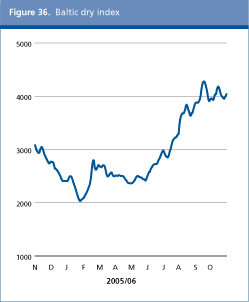OCEAN FREIGHT RATES
Contributed by the International Grains Council (http://www.igc.org.uk)
Ocean freight market (June 2006 – October 2006)
|
 |
Contrary to the usual seasonal drop in activity, ocean freight rates rose steadily during the northern hemisphere summer on growing demand. This was largely attributed to China’s strong iron ore imports from Brazil, bookings before the start of the peak United States grain export season and Europe’s increasing coal demand ahead of winter. Availability of vessels in prompt positions remained tight. Port delays, especially in Australia and in the Persian Gulf, kept tonnage off the market, thus strengthening rates further. Between early June and October, the Baltic Dry Index (BDI) climbed by around two-thirds, to over 4 000. The record was 6 200, in December 2004. Periodic dips in rates in July, August and October were due to temporary slowdowns in demand for minerals, increased spot tonnage availability, particularly in the Pacific and, more recently, lower bunker fuel prices.
 In the Panamax sector, heavy grain and soyabeans trade volumes out of South America, particularly from Brazil, boosted rates in the Atlantic. Short period rates continued to lead spot markets, while the splitting of larger cargoes into Panamax-size parcels additionally supported the market. Transatlantic round voyage rates increased by about US$10 000, to US$28 000 per day. Atlantic short period rates rose by about US$9 000, to US$30 000 daily. Compared with the beginning of June, the grain rate from the United States Gulf to Japan added US$13.00 (37 percent), to about US$48.00/tonne, while period rates on this route increased by US$11 000 - US$12 000, to about US$30 000 daily. In the Black Sea, a recent interruption in Ukraine’s wheat exports, caused by delays in issuing licences, forced some ship owners to move tonnage in ballast elsewhere. In the Pacific, China’s heavy demand for minerals and record coal shipments from Australia pushed freight rates to higher levels, also helped by India’s wheat purchases. Short-term period rates increased to about US$34 000 daily, nearly double those seen some five months earlier.
Capesize rates increased on good mineral demand, especially once China agreed to an increase in iron ore prices. Also supporting the market was a higher volume of enquiries for coal out of Australia as well as increasing coal shipments to Europe. A surge in time charter business triggered a rise in the spot market. In the Atlantic, the benchmark iron ore rate from Brazil to China increased from US$19.10 at the end of May to about US$29.00 per tonne, while the coal rate from South Africa to Europe ( Rotterdam) more than doubled, to US$23.25 (US$11.00) per tonne.
Demand in the Handysize sector remained healthy in both basins, helped by active grain and sugar trade. By the end of October, short period rates in the Atlantic were quoted at about US$27 000 (US$16 000) daily, while rates in the Pacific were in the region of US$30 000 (US$21 500). In the Atlantic, the grain rate from Brazil to the European Union ( Antwerp-Hamburg) increased by one-third, to US$46.00 (US$34.50) per tonne. Good demand for steel and fertilizer supported rates out of the Black Sea, quoted in October at around US$31 000 - US$32 000 daily. In Europe, hot weather during the summer months reduced river water levels, with barge ships on the Rhine utilizing only half of their capacity in this period.
|
 December 2006
December 2006 